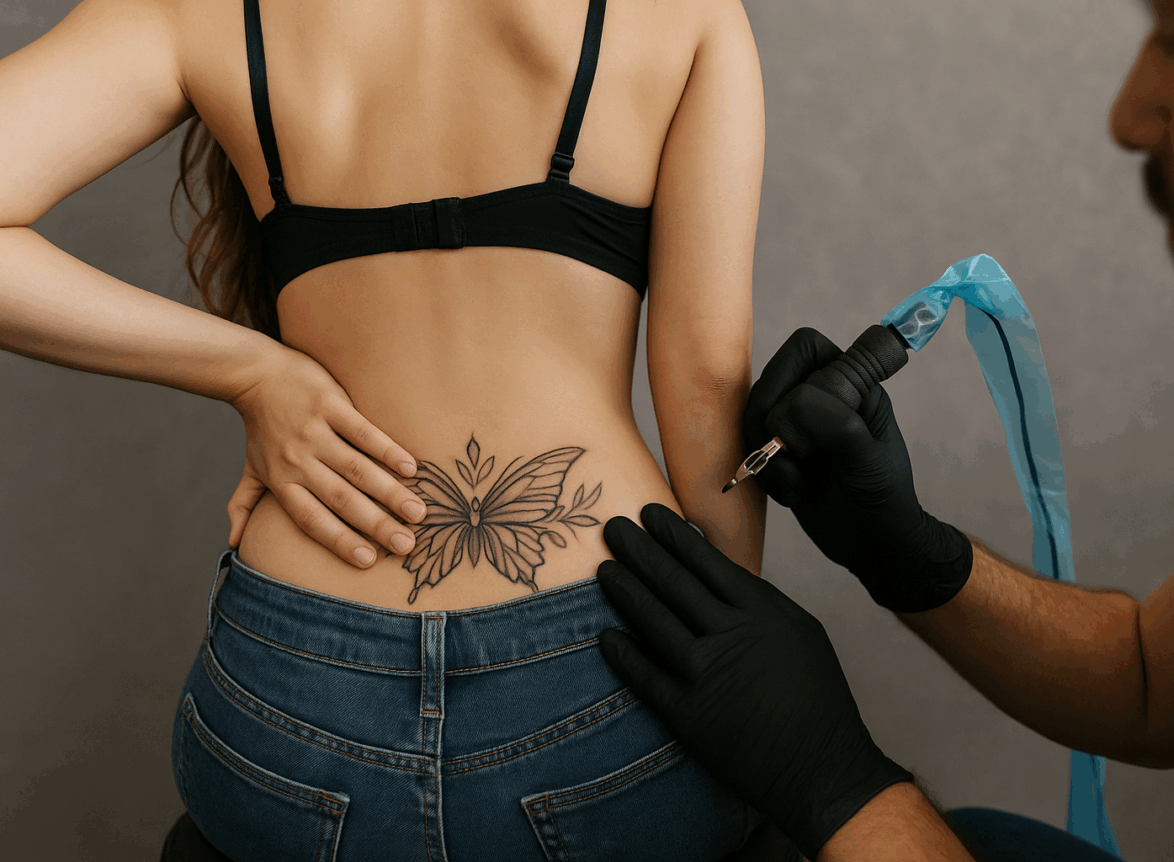Tattoos are powerful expressions of identity, art, healing, rebellion, and memory. But if you’re living with a back injury—whether chronic, temporary, or post-surgical—getting a tattoo isn’t just about picking a design or choosing a shop. It’s about protecting your spine, nerves, muscles, and posture while still getting inked safely.
So what happens when body art meets back pain? Can you still get tattooed? Absolutely. But you’ll need to think differently about placement, positioning, timing, artist communication, and aftercare.
This guide breaks down everything you need to know about getting tattooed safely with a back injury—so you don’t trade pain for art you love.
🧠 First: Know Your Injury
Not all back injuries are the same—and not all affect tattooing in the same way. Your tattoo experience will vary based on where the injury is, how severe it is, and how well it’s managed. Understanding what’s happening inside your body helps you make smarter choices on the outside.
🔹 Common Types of Back Injuries:
- Herniated or Bulging Discs
Pressure on nerves or spinal cord from displaced spinal discs—often causes pain down the legs, tingling, or numbness. - Muscle Strains or Ligament Sprains
Localized pain, stiffness, and weakness. Usually temporary but painful with certain positions or movements. - Sciatica
Pain radiating down the leg due to sciatic nerve pressure. Often tied to disc issues or lower spine compression. - Spinal Stenosis
Narrowing of the spinal canal, leading to nerve pain and discomfort in standing or sitting. - Post-Surgical or Post-Injury Healing
Scar tissue, muscle imbalance, or spinal fusion healing. This adds complexity due to long-term positioning and pressure limitations.
✅ Can You Get a Tattoo If You Have a Back Injury?
In most cases, yes—with planning. Tattooing itself doesn’t usually interfere with the spine directly unless the tattoo is placed over the injured area. The real issue is positioning during the session, tension in the body, and how your nervous system reacts to pain or stress.
🔍 Before the Appointment: What to Plan and Prepare
1. Talk to Your Doctor First (Really)
If you’re under treatment, recently had surgery, or are managing nerve pain, your doctor or physical therapist can help you decide:
- If you’re cleared for long periods of sitting/lying
- If anti-inflammatory meds you’re on will affect healing
- Whether certain positions may worsen your condition
This step matters, especially if your back injury is more than just sore muscles.
2. Choose a Tattoo Placement That Respects Your Injury
Here are the rules of thumb:
- Avoid tattooing directly over injured or inflamed areas, especially around your spine or areas of radiating nerve pain.
- Consider front-facing placements (chest, arms, thighs, calves) that don’t require back support during the session.
- If you’re getting a back tattoo, be extra mindful of your ability to lie prone (face down) for extended periods.
3. Choose an Artist Who Understands Anatomy and Accessibility
Not all artists are equal when it comes to working with injured clients. Look for someone who:
- Is experienced with accessibility or chronic pain clients
- Is flexible with positioning (literally)
- Can set up in a private or comfortable way—not every shop chair works for every spine
You can even call ahead and say:
“Hey, I have a back injury and might need breaks or alternative seating. Are you cool with that?”
Most pros will say yes—but it’s good to confirm.
4. Bring Support Items to the Appointment
Pack your own:
- Lumbar pillow or back roll
- Portable seat cushion
- NSAIDs or prescribed pain meds (if allowed)
- Water, electrolytes, and snacks
- A small towel or heat pack if that helps your back
5. Eat Before You Go—And Stay Hydrated
Pain, hunger, dehydration, and physical tension are a bad combo—especially with a back injury. Have a full meal before your session, and sip water throughout to keep your body calm and regulated.
🪑 During the Appointment: Positioning, Comfort, and Communication
Tattoo sessions can last hours. If you already deal with nerve pain, spinal instability, or limited movement, even 20 minutes in the wrong position can make recovery worse.
Here’s how to stay safe during the session:
1. Be Upfront About Your Limits
When you arrive, let your artist know exactly what you’re dealing with:
“Hey, I’ve got a lower back injury and might need to change positions more often. Let me know if something isn’t working for you too.”
Good artists will adjust—not just for your sake, but to do their best work.
2. Negotiate Positioning That Works for You
- Can’t lie face down? Ask if the piece can be done with you sitting slightly leaned forward instead.
- Can’t sit upright long? Opt for a reclined chair or side-lying position if the piece allows.
- Getting a full back piece? Break it into multiple shorter sessions instead of one marathon.
Pro tip: Bring your lumbar roll or cushion and test the position before they start inking.
3. Take Frequent Micro-Breaks
Don’t tough it out if your spine starts screaming. Build in a 5-minute stretch, walk, or rest every 30–45 minutes. It’ll help both your back and your endurance during long sessions.
4. Use Your Breath to Manage Pain and Tension
You’ll likely tense up more if your back is already sensitive. Deep breathing techniques can:
- Lower your heart rate
- Release muscle clenching
- Help your nervous system stay calm
Breathe slow and deep—especially during painful areas. It won’t fix your back, but it will keep your body from going into fight-or-flight.
🧴 After the Appointment: Healing Without Reinjuring
Healing a tattoo is normally about skin. But with a back injury, it’s also about avoiding flare-ups, staying mobile, and not triggering inflammation that can spread.
1. Avoid Excessive Sitting or Lying Still Right Afterward
Even if you’re exhausted, too much downtime right after a session can stiffen your back, slow circulation, and increase discomfort. Light walking, stretching, or moving every hour will help.
2. Keep the Tattoo Area Accessible for Aftercare
If your tattoo is in a place you can’t reach easily due to limited back movement, have someone help with ointment and washing. Twisting awkwardly to reach your ink can strain healing muscles or discs.
3. Sleep Smart
Avoid sleeping directly on the tattoo and in positions that aggravate your injury. If your ink is on your side or back:
- Use pillows to prop yourself into a pain-free position
- Keep the area breathable and elevated if swollen
- Don’t sleep on fresh ink for the first few days
4. Monitor for Flare-Ups
Watch for:
- Increased nerve pain
- Sharp spikes in back stiffness or spasms
- Loss of mobility
If any of these worsen dramatically after your session, it may not be the tattoo—it could be how you were positioned for too long. Let your doctor or physical therapist know.
📍 Tattoo Placement Ideas That Work Better for People With Back Issues
Depending on your mobility and comfort level, some placements will be easier to tolerate than others. Here are some back-injury-friendly options:
✅ Better Placement Ideas:
- Upper arm or forearm (easy to access, easy to sit during)
- Thigh (you can lie on your side)
- Calves or ankles (leg elevation possible)
- Chest or upper torso (works well while reclining)
- Ribcage (side) if you can lie comfortably on the opposite side
🚫 More Difficult (But Not Impossible):
- Lower back or spine (requires face-down positioning)
- Back of neck (still involves leaning forward or face-down)
- Full back pieces (can be broken up into sessions or repositioned creatively)
- Buttocks or hips (hard to lie or sit on afterward)
🙋 FAQs: Tattooing With a Bad Back
Q: Should I take painkillers before the session?
A: Some tattoo artists prefer you avoid NSAIDs like ibuprofen due to slight blood thinning, but Tylenol is usually okay. Always ask your artist—and never mix prescription painkillers without medical approval.
Q: What if my back injury is from a car accident or trauma?
A: Talk to a medical professional first. Certain spinal cord injuries or nerve damage might require clearance before staying in fixed positions.
Q: Can tattoos help me reclaim my body after back trauma?
A: Absolutely. Many people choose to tattoo near scars or around injury areas as a way of taking ownership of pain or recovery. Just make sure the area is fully healed and you’re physically ready.
💡 Final Thoughts: Art and Pain Can Coexist—Safely
You don’t have to give up tattoo dreams just because your back isn’t perfect. Whether you’re working with a slipped disc, post-op healing, or long-term pain, there is a way to get inked without making things worse.
It starts with:
- Choosing smart placements
- Communicating with your artist
- Listening to your body
- Balancing your art with your health
Tattoos are more than skin deep—especially when your body’s been through something. Getting tattooed with a back injury isn’t just about looking good. It’s about taking back space, honoring your limits, and making art that doesn’t come at your body’s expense.

